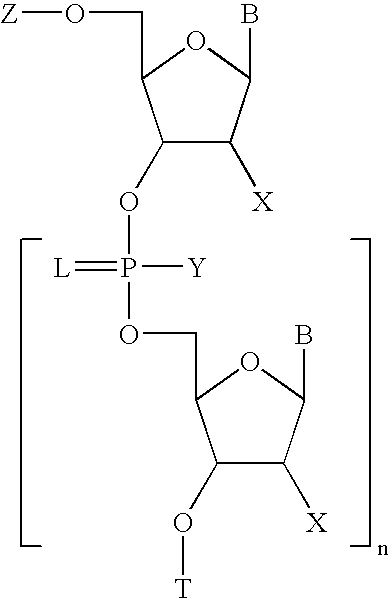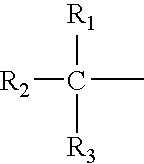Methods for synthesis of oligonucleotides
a technology of oligonucleotide and synthesis method, which is applied in the field of synthesis of oligonucleotides, can solve the problems of inability to be exposed to aggressive mixing, labor intensive and time-consuming, and the fragile silica support suitable for anchoring the oligonucleotide is difficult to achiev
- Summary
- Abstract
- Description
- Claims
- Application Information
AI Technical Summary
Benefits of technology
Problems solved by technology
Method used
Image
Examples
example 1
Synthesis of 5′-TTTTTTT-3′ Phosphorothioate Heptamer
[0112]50 milligram (2 μmole) of 5′-O-dimethoxytritylthymidine bound to CPG (controlled pore glass) through an ester linkage is taken up in a glass reactor, and a toluene solution of 3% dichloroacetic acid (volume / volume) is added to deprotect the 5′-hydroxyl group. The product is washed with acetonitrile. Then, a 0.2 M solution of 5′-O-(4,4′-dimethoxytrityl)thymidine-3′-O-(2-cyanoethyl N,N-diisopropylphosphoramidite) in acetonitrile and a 0.4 M solution of 1H-tetrazole in acetonitrile is added, and allowed to react at room temperature for 5 minutes. The product is washed with acetonitrile, and then a 0.2 M solution of phenylacetyl disulfide in acetonitrile:3-picoline (1:1 v / v) is added and allowed to react at room temperature for 3 minutes. This sulfurization step is repeated one more time for 3 minutes. The support is washed with acetonitrile, and then a solution of acetic anhydride / lutidine / THF (1:1:8), and N-methyl imidazole / THF...
example 2
Synthesis of 5′-d(GACT)-3′ Phosphorothioate Tetramer
[0114]50 milligram (2 μmole) of 5′-O-dimethoxytritylthymidine bound to CPG (controlled pore glass) through an ester linkage is taken up in a glass reactor, and a toluene solution of 3% dichloroacetic acid in toluene (volume / volume) is added to deprotect the 5′-hydroxyl group. The product is washed with acetonitrile. Then, a 0.2 M solution of 5′-O-(4,4′-dimethoxytrityl)thymidine-3′-O-(2-cyanoethyl N,N-diisopropylphosphoramidite) in acetonitrile and a 0.4 M solution of 1H-tetrazole in acetonitrile is added, and allowed to react at room temperature for 5 minutes. The product is washed with acetonitrile, and then a 0.2 M solution of phenylacetyl disulfide in acetonitrile:3-picoline (1:1 v / v) is added and allowed to react at room temperature for 3 minutes. This sulfurization step is repeated one more time for 3 minutes. The support is washed with acetonitrile and then a solution of acetic anhydride / lutidine / THF (1:1:8), and N-methyl imi...
example 3
Synthesis of Fully-Modified 5′-d (TCC-CGC-CTG-TGA-CAT-GCA-TT)-3′ Phosphorothioate 20-mer
[0119]The synthesis of the above sequence was performed on a Pharmacia OligoPilot II Synthesizer on a 620 μmole scale using the cyanoethyl phosphoramidites and Pharmacia's PRIMAR support. Detritylation was performed using 3% dichloroacetic acid in toluene (volume / volume). Sulfurization was performed using a 0.2 M solution of phenylacetyl disulfide in acetonitrile:3-picoline (1:1 v / v) for 2 minutes. At the end of synthesis, the support was washed with acetonitrile, treated with 30% aqueous ammonium hydroxide solution for 90 minutes at room temperature and then incubated at 55° C. for 24 hours to give the product.
PUM
| Property | Measurement | Unit |
|---|---|---|
| Fraction | aaaaa | aaaaa |
| Fraction | aaaaa | aaaaa |
| Covalent bond | aaaaa | aaaaa |
Abstract
Description
Claims
Application Information
 Login to View More
Login to View More - R&D
- Intellectual Property
- Life Sciences
- Materials
- Tech Scout
- Unparalleled Data Quality
- Higher Quality Content
- 60% Fewer Hallucinations
Browse by: Latest US Patents, China's latest patents, Technical Efficacy Thesaurus, Application Domain, Technology Topic, Popular Technical Reports.
© 2025 PatSnap. All rights reserved.Legal|Privacy policy|Modern Slavery Act Transparency Statement|Sitemap|About US| Contact US: help@patsnap.com


